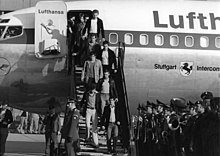
Back Terrorismus in Deutschland German تروریسم در آلمان Persian Terrorisme en Allemagne French טרור בגרמניה HE Терроризм в Германии Russian

| Year | Incidents | Deaths | Injuries |
|---|---|---|---|
| 2024 | 1 | 8 | 205 |
| 2020 | 3 | 11 | 12 |
| 2019 | 12 | 3 | 14 |
| 2018 | 22 | 0 | 8 |
| 2017 | 27 | 1 | 10 |
| 2016 | 44 | 27 | 117 |
| 2015 | 66 | 1 | 38 |
| 2014 | 13 | 0 | 0 |
| 2013 | 0 | 0 | 0 |
| 2012 | 5 | 0 | 0 |
| 2011 | 8 | 2 | 2 |
| 2010 | 1 | 0 | 0 |
| 2009 | 4 | 0 | 0 |
| 2008 | 3 | 0 | 2 |
| 2007 | 3 | 1 | 1 |
| 2006 | 4 | 2 | 0 |
| 2005 | 3 | 2 | 0 |
| 2004 | 3 | 1 | 25 |
| 2003 | 2 | 0 | 0 |
| 2002 | 3 | 0 | 2 |
| 2001 | 8 | 3 | 6 |
| 2000 | 8 | 1 | 28 |
| 1999 | 13 | 3 | 47 |
| 1998 | 6 | 0 | 0 |
| 1997 | 12 | 0 | 27 |
| 1996 | 52 | 1 | 5 |
| 1995 | 147 | 10 | 26 |
| 1994 | 79 | 2 | 85 |
| 1993 | 37 | 7 | 58 |
| 1992 | 156 | 17 | 217 |
| 1991 | 65 | 10 | 35 |
| 1990 | 13 | 1 | 4 |
| 1989 | 22 | 5 | 8 |
| 1988 | 18 | 1 | 14 |
| 1987 | 20 | 2 | 33 |
| 1986 | 49 | 10 | 276 |
| 1985 | 57 | 9 | 114 |
| 1984 | 22 | 0 | 3 |
| 1983 | 6 | 2 | 25 |
| 1982 | 30 | 5 | 44 |
| 1981 | 31 | 2 | 31 |
| 1980 | 20 | 17 | 218 |
| 1979 | 17 | 0 | 10 |
| 1978 | 20 | 0 | 4 |
| 1977 | 41 | 6 | 2 |
| 1976 | 50 | 4 | 36 |
| 1975 | 35 | 1 | 12 |
| 1974 | 29 | 2 | 10 |
| 1973 | 27 | 1 | 1 |
| 1972 | 24 | 23 | 45 |
| 1971 | 17 | 0 | 0 |
| 1970 | 32 | 8 | 9 |
| Total | 1,308 | 213 | 1,838 |
Germany has experienced significant terrorism in its history, particularly during the Weimar Republic and during the Cold War, carried out by far-left and far-right German groups as well as by foreign terrorist organisations.
In recent years, far-left, far-right and Islamist extremist violence have resurged, and groups have been suspected of terrorism or terrorist plans. The country has experienced several attacks and plots linked to Islamist extremists, prompting increased security measures and counterterrorism efforts. High-profile incidents, such as the 2016 Berlin Christmas market attack, point to the persistent danger of radicalization and violent extremism within Germany's borders.
Since the 2000s, jihadism in Germany has emerged as one of Europe's most dynamic scenes. This phenomenon is characterized by strong anti-American sentiment and extensive international networks. German-born jihadists, often radicalized in German cities, frequently travel to regions such as Turkey, Chechnya, Pakistan, Afghanistan and the Middle east. In these locations, they exchange ideologies and form alliances with various extremist organizations.[3]
- ^ National Consortium for the Study of Terrorism and Responses to Terrorism. (2016). Global Terrorism Database (globalterrorismdb_0616dist.xlsx). Retrieved from https://www.start.umd.edu/gtd University of Maryland
- ^ National Consortium for the Study of Terrorism and Responses to Terrorism. (2016). Global Terrorism Database (gtd1993_0616dist.xlsx). Retrieved from https://www.start.umd.edu/gtd University of Maryland
- ^ Steinberg, Guido W. (June 2013). German Jihad: On the Internationalization of Islamist Terrorism. Columbia University Press. ISBN 978-0-231-50053-1.